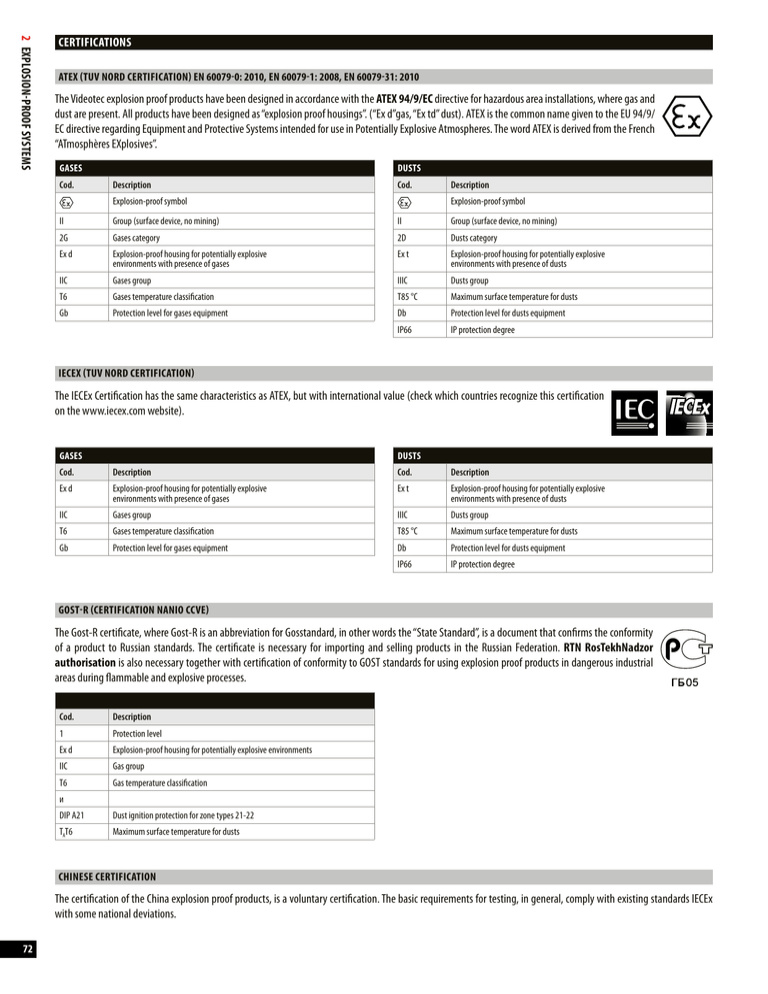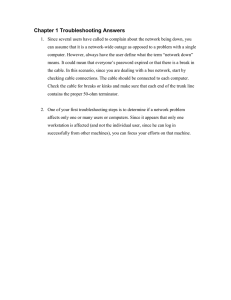
2 Explosion-proof systems
Certifications
ATEX (TUV Nord Certification) EN 60079-0: 2010, EN 60079-1: 2008, EN 60079-31: 2010
The Videotec explosion proof products have been designed in accordance with the ATEX 94/9/EC directive for hazardous area installations, where gas and
dust are present. All products have been designed as “explosion proof housings”. (“Ex d”gas, “Ex td” dust). ATEX is the common name given to the EU 94/9/
EC directive regarding Equipment and Protective Systems intended for use in Potentially Explosive Atmospheres. The word ATEX is derived from the French
“ATmosphères EXplosives”.
GASes
Cod.
Dusts
Description
Cod.
Explosion-proof symbol
Description
Explosion-proof symbol
II
Group (surface device, no mining)
II
Group (surface device, no mining)
2G
Gases category
2D
Dusts category
Ex d
Explosion-proof housing for potentially explosive
environments with presence of gases
Ex t
Explosion-proof housing for potentially explosive
environments with presence of dusts
IIC
Gases group
IIIC
Dusts group
T6
Gases temperature classification
T85 °C
Maximum surface temperature for dusts
Gb
Protection level for gases equipment
Db
Protection level for dusts equipment
IP66
IP protection degree
IECEx (TUV Nord Certification)
The IECEx Certification has the same characteristics as ATEX, but with international value (check which countries recognize this certification
on the www.iecex.com website).
GASes
Dusts
Cod.
Description
Cod.
Description
Ex d
Explosion-proof housing for potentially explosive
environments with presence of gases
Ex t
Explosion-proof housing for potentially explosive
environments with presence of dusts
IIC
Gases group
IIIC
Dusts group
T6
Gases temperature classification
T85 °C
Maximum surface temperature for dusts
Gb
Protection level for gases equipment
Db
Protection level for dusts equipment
IP66
IP protection degree
Gost-R (Certification NANIO CCVE)
The Gost-R certificate, where Gost-R is an abbreviation for Gosstandard, in other words the “State Standard”, is a document that confirms the conformity
of a product to Russian standards. The certificate is necessary for importing and selling products in the Russian Federation. RTN RosTekhNadzor
authorisation is also necessary together with certification of conformity to GOST standards for using explosion proof products in dangerous industrial
areas during flammable and explosive processes.
Cod.
Description
1
Protection level
Ex d
Explosion-proof housing for potentially explosive environments
IIC
Gas group
T6
Gas temperature classification
и
DIP A21
Dust ignition protection for zone types 21-22
TAT6
Maximum surface temperature for dusts
Chinese certification
The certification of the China explosion proof products, is a voluntary certification. The basic requirements for testing, in general, comply with existing standards IECEx
with some national deviations.
72
Electrical equipment is enclosed in housings that can contain any internal
explosion and prevent its transmission to the outside atmosphere without being
damaged.
According to standards EN60079-0 of CENELEC (European Committee
for Electrical Standards, or the European Committee for Electrotechnical
Standardization) and IEC 60079-0 (IECEx International Electrotecnichal
Commission System for Certification to Standards Relating to Equipment for use
in explosive atmospheres), the devices intended for use in potentially explosive
atmospheres are divided into three groups.
Group I
Group III
Electrical equipment of Group III is subdivided according to the nature of the
explosive dust atmosphere for which it is intended.
Group III subdivisions:
•IIIA - combustible flyings
•IIIB - non-conductive dust
•IIIC - conductive dust
2 Explosion-proof systems
Equipment Classification
Equipment marked IIIC is suitable for applications requiring Group IIIB and IIIA.
Temperature class
Group I equipment is intended for use in mines susceptible to firedamp (methane).
This group is divided into categories M1 and M2.
•M1 identifies equipment that must continue to operate when a potentially
explosive atmosphere is present.
•M2 identifies equipment that must not operate when a potentially explosive
atmosphere is present.
The temperature class is an important factor when selecting devices for detecting
gases or mixtures (in the case of gas mixtures it is advisable to consider the worst
component).
The temperature class refers to the maximum temperature that the surface of the
device can reach. This ensures that the ignition temperature of gases or vapours or
dust that may be present is not exceeded.
The field ranges from T1 to T6 for gases and 450°C to 85°C for dust. The certified
equipment shall be approved according to the gas, vapour or dust particle types.
Group II
Group II is intended for all other situations.
Group II obviously covers a wide range of potentially explosive gases and vapours
as well as many that can create different levels of risk. Therefore, in order to
distinguish more clearly the various characteristics required for a particular gas or
vapor, Group II gases are divided as shown in the table.
The group and the temperature class are listed in the certificate and on the unit
itself.
GAS GROUP CLASSIFICATION
Temperature class (Maximum surface temperature °C of the housing) *
Class
T1
450 °C
I
Methane
IIA
Acetone
Ethanol
Ethyl acetate
Ammonia
Pure benzene
Acetic acid
Carbon monoxide
Methanol
Propane
Toluene
IIB
IIC
T2
300 °C
T3
200 °C
T4
135 °C
N-Butane
N-Butyl
Petrol
Diesel fuel
Avgas
Heating oil
N-Hexane
Acetaldehyde
Ether
T5
100 °C
T6
85 °C
Ethyl nitrate
Ethylene
Hydrogen
Acetylene
Carbon disulphide
The above temperature classes automatically cover the lower classes (T6 is better than T1).
Class IIB also covers class IIA. Class IIC also covers classes IIB and IIA.
* Normally refers to the maximum ambient temperature of the installation. The lower is the ignition temperature of the related explosive atmosphere, the higher should be the maximum allowed surface temperature
of the housing.
www.videotec.com Data Sheets
Specifications subject to change without notice. © Videotec S.p.A. All rights reserved.
73
2 Explosion-proof systems
Cable glands
The use of different types of cable gland must follow the IEC/EN 60079-14
Standard. Depending on the type of installation (certification required) and the
volume of the housings, barrier cable glands or simple cable glands with gasket
can be used.
START
Choice of cable glands
The choice of cable glands must be made considering:
•the type of certification required
•the gas group
•type of cable, armoured or non-armoured
•temperature range
Normally, the glands are divided into two main categories: “Barrier” cable glands
and cable glands with gaskets.
YES
YES
DOES THE
HAZARDOUS GAS REQUIRE
IIC APPARATUS?
YES
YES
DOES THE HOUSING
CONTAIN AN
IGNITION SOURCE?
“Barrier” cable glands: The barrier cable glands are similar to normal cable
glands, except a compound sealant material is used to seal around the individual
cable cores, ensuring that the inside and outside of the cable are gas tight.
NO
Cable glands with gaskets: to be chosen according to the diameter of the cable.
Sealing is guaranteed by a rubber gasket that tightens around the diameter of the
cable. This prevents the spread of fire outside the housing.
NO
IS THE AREA
OF INSTALLATION
ZONE 1?
The minimum and maximum usable diameters of the cable are indicated on the
gaskets. It is forbidden to fit more than one cable in one cable gland, or increase
the outside diameter of the cable sheath with electric tape or in any other way
to make it correspond to the diameter of the gasket. Cable glands for armoured
cables have two gaskets: the first is at the front and seals the internal diameter
of the cable to protect against explosions; the second is at the rear and seals the
external sheath of the cable, protecting against liquid penetration inside the
gland, where the armour is blocked by two conical rings that provide electrical
continuity to earth.
NO
IS THE VOLUME
OF THE HOUSING
GREATER THAN 2 LITERS?
If you remove a cable gland for maintenance, you should replace the seals because
they could no longer be reliable.
In the below table the cable glands offered by Videotec.
CABLE GLAND
WITH GASKET
BARRIER
CABLE GLAND
SELECTION TABLE FOR CABLE GLANDS
Zone - Gas
Cable gland type
Certification
Operating temperature
IIC Zone 1 or Zone 2
IIB or IIA, Zone 1
Barrier
IECEX / ATEX / GOST
-60 / +80°C
IIB o IIA
Zone 2
-76 / 176°F
IECEX / ATEX / GOST
-60 / +100°C
-76 / 212°F
ATEX
-20 / +80°C
-4 / 176°F
With gasket
Cable
Cable glands
part code
External
diameter (mm)
Diameter
under armour (mm)
Not armored
OCTEXB3/4C
13 - 20.2
-
Armored
OCTEXBA3/4C
16.9 - 26
-
Not armored
OCTEX3/4C
13 - 20.2
-
Armored
OCTEXA3/4C
16.9 - 26
11.1 - 19.7
Not armored
OCTEX3/4
14 - 17
-
Armored
OCTEXA3/4
18 - 23
14 - 17
74
Videotec CCTV Products
Specifications subject to change without notice. © Videotec S.p.A. All rights reserved.



